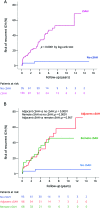Convexity subarachnoid hemorrhage in lobar intracerebral hemorrhage: A prognostic marker
- PMID: 32019785
- PMCID: PMC7238947
- DOI: 10.1212/WNL.0000000000009036
Convexity subarachnoid hemorrhage in lobar intracerebral hemorrhage: A prognostic marker
Erratum in
-
Convexity Subarachnoid Hemorrhage in Lobar Intracerebral Hemorrhage: A Prognostic Marker.Neurology. 2021 Aug 10;97(6):300. doi: 10.1212/WNL.0000000000011857. Epub 2021 Apr 1. Neurology. 2021. PMID: 33795394 Free PMC article. No abstract available.
Abstract
Objective: To investigate whether acute convexity subarachnoid hemorrhage (cSAH) associated with acute lobar intracerebral hemorrhage (ICH) increases the risk of ICH recurrence in patients with cerebral amyloid angiopathy (CAA).
Methods: We analyzed data from a prospective cohort of consecutive survivors of acute spontaneous lobar ICH fulfilling the Boston criteria for possible or probable CAA (CAA-ICH). We analyzed baseline clinical and MRI data, including cSAH (categorized as adjacent or remote from ICH on a standardized scale), cortical superficial siderosis (cSS), and other CAA MRI markers. Multivariable Cox regression models were used to assess the association between cSAH and recurrent symptomatic ICH during follow-up.
Results: We included 261 CAA-ICH survivors (mean age 76.2 ± 8.7 years). Of them, 166 (63.6%, 95% confidence interval [CI] 57.7%-69.5%) had cSAH on baseline MRI. During a median follow-up of 28.3 (interquartile range 7.2-57.0) months, 54 (20.7%) patients experienced a recurrent lobar ICH. In Cox regression, any cSAH, adjacent cSAH, and remote cSAH were independent predictors of recurrent ICH after adjustment for other confounders, including cSS. Incidence rate of recurrent ICH in patients with cSAH was 9.9 per 100 person-years (95% CI 7.3-13.0) compared with 1.2 per 100 person-years (95% CI 0.3-3.2) in those without cSAH (adjusted hazard ratio 7.5, 95% CI 2.6-21.1).
Conclusion: In patients with CAA-related acute ICH, cSAH (adjacent or remote from lobar ICH) is commonly observed and heralds an increased risk of recurrent ICH. cSAH may help stratify bleeding risk and should be assessed along with cSS for prognosis and clinical management.
© 2020 American Academy of Neurology.
Figures



Comment in
-
To predict recurrence in cerebral amyloid angiopathy, look to the subarachnoid space.Neurology. 2020 Mar 3;94(9):375-376. doi: 10.1212/WNL.0000000000009029. Epub 2020 Feb 4. Neurology. 2020. PMID: 32019786 No abstract available.
References
-
- Charidimou A, Gang Q, Werring DJ. Sporadic cerebral amyloid angiopathy revisited: recent insights into pathophysiology and clinical spectrum. J Neurol Neurosurg Psychiatry 2012;83:124–137. - PubMed
-
- van Asch CJ, Luitse MJ, Rinkel GJ, van der Tweel I, Algra A, Klijn CJ. Incidence, case fatality, and functional outcome of intracerebral haemorrhage over time, according to age, sex, and ethnic origin: a systematic review and meta-analysis. Lancet Neurol 2010;9:167–176. - PubMed
-
- Moulin S, Labreuche J, Bombois S, et al. Dementia risk after spontaneous intracerebral haemorrhage: a prospective cohort study. Lancet Neurol 2016;15:820–829. - PubMed
Publication types
MeSH terms
Grants and funding
LinkOut - more resources
Full Text Sources
